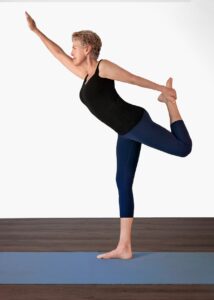After all those quiet months, suddenly there is so much to do. June’s arrival on Outer Cape Cod can make a person feel scattered. That is why this month I’m turning to Natarajasana, Dancer Pose or Lord of the Dance Pose. It is all about balance and focus.
Natarajasana engages the body in several ways. It strengthens your legs and ankles, opens your hips, and stretches your shoulders and chest. It’s a standing pose and a backbend. It symbolizes a connection to the Hindu god Lord Nataraja, the King of Dance and one of the eight forms of Shiva, the creator and destroyer in Hindu philosophy, who represents the cosmic dance at the source of everything in the universe.
Even if you’re not into yoga philosophy, doesn’t June — this time of green growth and blossoming — just make you want to dance? Yet this pose can look intimidating. I encourage you to join this dance step by step, trying the pose in stages, and going only as far into it as you are able, keeping in mind, as always, that yoga is not meant to be painful.
First, you will need some props to get comfortably into the Dance Pose: a chair or wall to lean on, a belt, and a yoga mat or other surface that is not slippery to stand on.

I recommend you warm up before doing the pose with some gentle movement and breathing. If you haven’t kept doing it, you might revive the “empty coat sleeves” warm-up I wrote about last June: Stand with your feet wider than your hips and let your arms hang loose; begin to swing them from side to side, turning at the waist, relaxed and easy. Twisting back and forth, get a relaxed rhythm going. Add some intentional breathing by inhaling to one side and exhaling to the other. Feel your body start to let go, your breath open. Do this for 30 seconds or so.
Stand in Tadasana, arms at your sides, feet about hip-width apart, feet parallel. Yes, we are still only just getting into the pose. Take your time. Feel your feet on the floor. Imagine you are growing roots down into the floor and feel how it grounds you.
Imagine you are heavy, like a sandbag, from the waist down, and that from the waist up you are as light as a feather. Your spine is like a string connecting your head, which floats up above you like a balloon. Relax your shoulders.

From here, finally, you can move into the pose. Be sure to have a chair or wall within reach to lean on and help you balance. Bend your right leg, bringing your right heel toward your buttocks. Take hold of your right ankle with your right hand or use a belt or strap if you can’t reach your ankle. Bring your right knee in line with the left knee. Align your hips.
Now bring your focus to the left leg. Press into your left big toe mound and tighten the muscles above your left knee. This will help stabilize your left leg. Engage your core by lifting the muscles just below your navel in and up, at the same time tucking the lower ribs in and knitting the ribs together.
Keep this alignment in your hips as you begin to lean forward and at the same time draw your right thigh back and up. Pick a spot on the floor in front of you or on the wall and fix your gaze on this point. This is called a Drishti point. It will help you to gather yourself and concentrate. If you’re steady, try letting go of the chair and lifting the left arm up and forward in front of you. Lift from your shoulder and upper arm as you extend through your fingers. If you are using a wall to balance, you can move your arm up the wall.
Take a few breaths. Release your right leg to the floor and return to Tadasana, standing on both legs, arms at your side. Try the pose on the other side. Take a few breaths and notice how you feel.
Moving slowly into this dance with June and the cosmos, I think of one of my teachers, Karin Stephan, who lives in Cambridge now but studied with B.K.S. Iyengar in India. I can hear her voice repeating something she often says: “Getting into the pose is the pose.”



